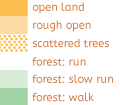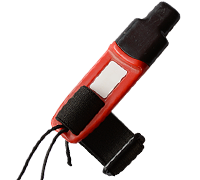Newcomers
What is orienteering?
How does it work?
How much does it cost?
How much do I need to know?
What's an e-punch?
Do I have to run?
How long will it take me?
How do I choose a course?
What should I wear?
Can I do it in a group?
Can I bring my dog?
Will it be crowded?
Can I follow other people?
What do I do if I get lost?
What do I do if I become injured on the course?
What happens at course closure time?
What if I don't finish my course?
What is orienteering?
Orienteering is a navigation sport! Checkpoints are circled on a specially prepared map, and you decide your own route between them.
Should you go straight, through the forest and up the hill? Or perhaps take the longer but flatter trail for awhile? These are the kinds of decisions that run through an orienteer’s mind.
Orienteers use only map and compass to navigate, but compass knowledge is not needed to get started. In fact, the primary skill in orienteering is reading the map and relating it to the terrain, and you can do that with just your eyeballs.
How does it work?
WHEN YOU ARRIVE
Check-in at registration, pay your fee and pick up an e-punch, whistle, and compass if you need them. A newcomer instructor will be hanging out near registration, and can give you a quick tutorial on what to expect and how to read the map.
Interval Starts
At an interval-start event, there is a start window (usually 2 hours), meaning that you can start anytime in that time window. Participants start in waves one to two minutes apart. The start is at a tent, usually with chutes coming out of it. At Winter League events, we are currently using pre-assigned start times. You may request a start time when you register (we can’t guarantee that you will get the time you requested but we will try to assign you a time as close as possible). Look for an email a day or two before the event with a link to the list of start times.
THE START TENT
- At the entrance to the tents, dip your e-punch into an electronic box that says “CLEAR”; this will clear the old data off your e-punch.
- Find the chute with your course labeled on it, and take a control description (more on that later) which is a small slip of paper.
- When it’s your turn, follow the start volunteer’s instructions.
- The start volunteer have you dip your e-punch into a “CHECK” box to check that it has been cleared.
- (Dipping your e-punch into a box is called “punching.”)
- The start volunteer will then tell you when you can pick up your map (but don’t look at it yet!), and will confirm that you have the correct course map.
- And finally, the start volunteer will tell you when you can proceed to the start, which is a sawhorse just a few meters ahead with an electronic “START” box on it.
- As soon as you punch the “START” box, your race clock begins, and you may look at your map!
Mass Starts
At a mass-start event, everyone starts at the same time, which is very exciting. You will still clear and check your e-punch, but will not need to punch a start. Arrive at the start area 10 minutes before the start time to receive the Meet Director’s final instructions.
NAVIGATING THE COURSE
Alright, the race has begun, now what?
- Find the start on the map, which is a magenta triangle
- Orient the map, so that it matches the terrain
- Put your thumb or compass tip on the map, to track where you are
- Find the next checkpoint on the map, choose a route, and off you go!
Visit the Skills page to learn basic navigation skills.
At an interval-start event, you’ll need to find the checkpoints in their labeled order (number 1, 2, 3, and so on). Each checkpoint is in the exact center of a magenta circle on the map, with magenta lines connecting them to help you see where the next one is. You do not need to travel on the line, rather, you get to choose your own route!
At most mass-start events, you can find checkpoints in any order!
Also, in orienteering-speak, checkpoints are called “controls.”
FINDING A CONTROL
So you’ve navigated your way to the center of a circle; what are you going to find there? A bright orange and white flag, likely hanging from a stand, with a numbered electronic box on top.
So you should punch it, right? But wait! If there are multiple courses, you need to make sure that this control is on your course and not another. That’s what the control description is for, that little slip of paper you got in the start chute. Control descriptions are also printed directly on the map.
CONTROL DESCRIPTIONS
The first column numbers the order that you must find the checkpoints, the second column shows the number that you will find printed on top of the electronic box on top of the control, and the other columns have strange hieroglyphics that aren’t important to understand quite yet.
PUNCH!
If the number in the second column of the control description matches the number you see on top of the control, then dip your e-punch into the electronic box. The box will beep and flash as confirmation. In the rare case that the box does not beep or flash, use the red pinhole-punch dangling from the flag to punch your map (it does not matter where).
Note: it’s okay if you accidentally punch the wrong control, so long as you eventually punch all the correct controls in the correct order.
FINISHING
Once you’ve found all the controls on your course, head to the finish, which is marked as two concentric circles on the map. Similar to the start, there will be a sawhorse with electronic boxes on top. Once you punch the finish, your race clock stops.
DOWNLOAD
After you finish, go to the download tent (there will be signs) to download the data from your e-punch. If you’ve rented an e-punch, you can also return that here.
Once you’ve downloaded, you’ll get a receipt that shows your split times, which is the amount of time you took between each control. Part of the fun of orienteering is comparing your splits with friends, and discussing the routes you took between each.
Even if you have not finished your course, you MUST return to download, so that event staff can confirm that you are not still out on the course. If you do not download, a search party may be sent after you.
YOU DID IT!
That’s it, you did it!
How much does it cost?
- Pricing for orienteering events is generally less than for road running events. It typically begins at $22, but with various discounts for online registration, equipment ownership, and membership, your cost per event can be as low as $12.
- If you want to run in a group, the group leader pays full price and each additional adult (16+) group member pays $5.
- There is special beginner-level pricing. At some events we offer a beginner course with navigation that is pretty simple, so we price it at only $5.
- There is a discount for second courses. Often, people go out again at the same event! A second course after a regularly priced course costs just $5. (A second course after the $5 beginner course is full-priced).
How much do I need to know?
You don’t need to know a thing!
That’s right. Most events feature a beginner and intermediate course, or are otherwise adjustable to your ability. Plus, every event is staffed with a newcomer instructor who hangs out near registration to get you started.
If you can find the kangaroos by reading a zoo map, then you can orienteer.
What's an e-punch?
An e-punch records your race. At each control, you’ll dip the e-punch into an electronic box, which will beep and flash as confirmation. After you finish, you’ll download the e-punch at the download tent and get a receipt that show which controls you visited and how long you took between each; these are your “splits.”
Part of the fun of orienteering is comparing your splits with people who completed the same course, and discussing the routes you took!
Do I have to run?
Orienteering is for all speeds, fast and slow. Whether you want a thrilling or relaxing experience is up to you!
How long will it take me?
First of all, courses are measured as the crow flies, meaning directly from one checkpoint to another. However, since you are not a crow or bumblebee, you will travel farther than this distance as you zig-zag to get to each checkpoint. Course distances are published in kilometers, so a good rule of thumb is to ’round up’ the kilometers to miles to approximate how far you will go.
So for example, at a 5-km course, you may actually travel about 5 miles.
Alright, now that you’ve estimated how far you will go, anticipate moving a bit slower than your average hiking or trail running pace (depending on whether you plan to hike or run). You can only move as fast as you can navigate! Plus, waist-high ferns can really slow you down. Also, you are bound to get a bit fuddled here and there.
Still want a ballpark? Most courses take about 40-90 minutes, with some notable outliers.
How do I choose a course?
Not sure which course to choose?
INTERVAL-START EVENTS generally offer a Beginner, Intermediate, Short Advanced, and Long Advanced option.
- Beginner courses stay on trails, and are good for children accompanied by adults.
- Intermediate courses take short excursions off-trail, and are appropriate for new teens and adults.
- Advanced courses may have routes completely off-trail, and may require reading subtle map details to navigate. The challenge of an advanced course depends heavily on the venue, so read the map notes for more information on what to expect.
Read the article “Choosing a Course at Winter Series” for more guidance.
MASS-START EVENTS are typically score-o format, meaning that you can find checkpoints (“controls”) in any order and the goal is to find as many as you can within a time limit.
There are no course levels for score-os, however, this format is especially beginner-friendly, since you get to decide the difficulty of every control, simply by choosing which to find. Also, if you’re having trouble finding a control, you can just skip it!
What should I wear?
Dress for your speed. If you plan to walk, quick-drying hiking pants and day hiking shoes are a good choice. If you plan to run, running tights, tall socks, and trail running shoes will suit you better.
Cover your legs. Even in a seemingly tame park, you may find yourself wading through ferns or swimming in salal. Except for at very urban venues, leg coverage is advised, whether it’s pants, soccer socks, or even a padded gaiter.
Can I do it in a group?
Yes! You may participate in a group. Group size limits vary by series, venue, and health factors. Maximum group size will always be 6 but may be less at a series director’s discretion. You will see the maximum allowed when you register.
Also, we recommend that everyone in your group carry a map.
Can I bring my dog?
Yes, so long as the park permits dogs, you are welcome to bring yours so long as they are on a leash and you clean up any mess than others could step in.
Also, please be mindful of other orienteers trying to pass you or punch a control, and ensure that your dog does not interfere with others.
Will it be crowded?
Typically, no.
At an interval start event, only a handful of participants start their course every minute or two, which spaces people out.
Even at a mass start event, participants can typically begin in any direction they want, which also spreads people out.
So even at a large event with 300 people, your experience out on the course will really be your own!
You’ll see people going to and from controls, but they’re likely on a different course or at a different point in your course than you.
Can I follow other people?
Most orienteering events are designed to discourage following. If you see another orienteer, they may be on a different course, at a different point on your course, or they could even be making a navigational mistake! It’s better to focus on your own race, and don’t follow others.
What do I do if I get lost?
If you don’t know where you are on the map:
- Stop!
- Put your map down, look around you, and look at the features you see in the terrain. It’s okay to move around or seek higher ground to see more features. Note what direction the features are facing as well.
- Try again to find those features on the map, in the orientation that you see them.
If you’re still confused, then either:
- Go to a larger, more prominent feature and try again.
- Or, backtrack to where you last knew you were.
Finding larger features and backtracking are usually enough to relocate yourself, but if you are still very confused, it is okay to ask for help if you encounter a non-competitive orienteer. You are more likely to encounter an orienteer by waiting near a control.
If you are still very confused and don’t see anyone around, you should do one of the following, depending on your situation:
- Head toward a large feature like a road to head back to the finish, if you are confident in your ability to do so. Many venues, even very rugged ones, have large features like roads that can help you navigate back to the finish.
- If you cannot navigate back to the finish, due to being absolutely lost or injured, then blow your whistle using three short blasts, and repeat until someone finds you. Note that orienteers are obligated to abandon their course and attend to the call of a whistle, so only blow your whistle if you are truly lost or hurt and cannot make it back to the finish.
And finally, if you do not return to the finish by course closure time, a search party will be organized to find you.
What do I do if I become injured on the course?
All participants MUST carry a whistle on the course. Complimentary whistles are available at the start tent (please only take one).
If you are injured on the course and need assistance, blow three long blasts to call for help.
If you hear a call for help, abandon your course to find the person in distress.
What happens at course closure time?
At the course closure time, volunteers will begin picking up the controls.
You MUST return to the finish by course closure time. If you do not return by course closure, event volunteers will begin coordinating a search party.
If you need a long time on the course, start as early in the start window as possible, wear a watch, and be prepared to cut your course short to make it back by the course closure time.
What if I don't finish my course?
If you’re ready to call it a day, you are welcome to cut your course short. However, you MUST return to the finish tent to inform staff that you have returned safely.






